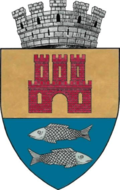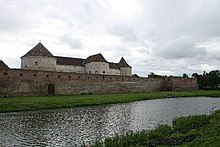Fagaras
|
Făgăraș Fogarasch, Fugreschmarkt Fogaras |
||||
|
||||
| Basic data | ||||
|---|---|---|---|---|
| State : |
|
|||
| Historical region : | Transylvania | |||
| Circle : | Brașov | |||
| Coordinates : | 45 ° 51 ′ N , 24 ° 58 ′ E | |||
| Time zone : | EET ( UTC +2) | |||
| Height : | 429 m | |||
| Area : | 36.41 km² | |||
| Residents : | 30,714 (October 20, 2011) | |||
| Population density : | 844 inhabitants per km² | |||
| Postal code : | 505200 | |||
| Telephone code : | (+40) 02 68 | |||
| License plate : | BV | |||
| Structure and administration (as of 2016) | ||||
| Community type : | Municipality | |||
| Mayor : | Gheorghe Sucaciu (independent) | |||
| Postal address : | Str.Republicii, No. 3 Loc. Făgăraș, jud. Brașov, RO-505200 |
|||
| Website : | ||||
Făgăraș [ fəɡəˈraʃ ] ( German Fogarasch or Fugreschmarkt , Hungarian Fogaras ) is a city in the Brașov district in Transylvania , Romania . The Olt ( Alt ) flows through the city .
history
The city is shaped by a castle. A legend reports that Prince Negru Vodă moved from this place to found the Principality of Wallachia south of the Southern Carpathians . At the end of the 12th century the castle was just a wooden fortress, which was then expanded into a stone fortress in the 14th century.
In the Kingdom of Hungary , the city was the administrative seat for Fogaras County and in the Kingdom of Romania for Făgăraş County .
A 270 m long covered bridge crossed the Aluta River. In 1613 Gábor Bethlen built a fortified castle. In 1881 there were five churches in the city; At that time, 5,307 inhabitants lived there, doing trade, industry and tobacco growing. The city was the seat of a district court and had a Protestant grammar school.
At Făgăraş on July 12, 1849 Józef Bem was defeated by the Russians.
In the 20th century, the place was considered an anti-communist stronghold during communist rule. In the 1950s the castle was a prison in which many enemies of communism were interned. The castle was restored during the communist dictatorship and now houses a museum and library.
Făgăraș had about 39,000 inhabitants in 2007. Of these, around 306 were Transylvanian Saxons , as can be seen from a church list from 2009.
The Doamna-Stanca-Gymnasium has a German department in which all subjects are taught in German. The students are mostly Romanians, rarely Transylvanian Saxons.
population
| census | Ethnicity | |||||||
|---|---|---|---|---|---|---|---|---|
| year | Residents | Romanians | Hungary | German | Other | |||
| 1850 | 4,903 | 2,061 | 944 | 1,249 | 649 | |||
| 1900 | 7,493 | 3,293 | 2,918 | 1,266 | 11 | |||
| 1930 | 8,848 | 5,212 | 2,099 | 971 | 566 | |||
| 1956 | 17,256 | 14,046 | 1,634 | 1,222 | 354 | |||
| 1977 | 33,827 | 28,143 | 2,592 | 2,550 | 542 | |||
| 1992 | 44,931 | 44,018 | 2,337 | 966 | 610 | |||
| 2002 | 36,121 | 33,677 | 1,643 | 332 | 469 | |||
| 2011 | 30,714 | 25,853 | 1,056 | 192 | 3,613 | |||
Since the official survey of 1850, Făgăraş had the highest population, and that of Romanians, in 1992. The highest population of Germans was determined in 1977, that of Magyars (3367) in 1910 and that of Roma (1069) in 2011. Furthermore, Ukrainians (highest population 61,930), Serbs (highest population 91,966) and Slovaks (highest population 14.1930) were registered in almost every recording .
Personalities
- Michael Apafi I (1632–1690), Prince of Transylvania, died in Făgăraş
- Adolf Schullerus (1864–1928), educator, scientist, episcopal vicar and politician
- Fritz Schullerus (1866–1898), painter, died in Cincu
- Mihály Babits von Szentistván (1883–1941), poet and publicist, worked as a teacher in Făgăraş from 1908–1911
- László Egyed (1914–1970), geophysicist.
- Otto Ernest Weber (1921–2001), Romanian German politician
- Eginald Schlattner (* 1933), pastor and writer, lived temporarily in Făgăraș
- Carmen Daniela (* 1951), pianist
- Ioan Viorel Ganea (* 1973), football player
See also
Web links
Individual evidence
- ↑ a b 2011 census in Romania ( MS Excel ; 1.3 MB)
- ↑ Dieter Drotleff: Pastors, curators, numbers of souls. In: Allgemeine Deutsche Zeitung. Enclosure: Karpatenrundschau , March 4, 2010, p. 3.
- ↑ Ernszt Árpád Varga: Brassó megye településeinek etnikai (anyanyelvi / nemzetiségi) adatai 1850–2002. (pdf, 512 kB) In: A Kulturális Innovációs Alapítvány Könyvtára. November 9, 2010, pp. 3–4 , accessed on January 30, 2019 (Hungarian, “Statistics of the population by ethnicity in the Brașov district according to censuses from 1850–2002”).
- ↑ Information on Adolf Schullerus at Kulturportal West-Ost , accessed on March 9, 2020
- ^ MJ Tataru: Schullerus, Fritz (1866–1898), painter. In: Austrian Biographical Lexicon 1815–1950 (ÖBL). Volume 11, Verlag der Österreichischen Akademie der Wissenschaften, Vienna 1999, ISBN 3-7001-2803-7 , p. 333 f. (Direct links on p. 333 , p. 334 ).


